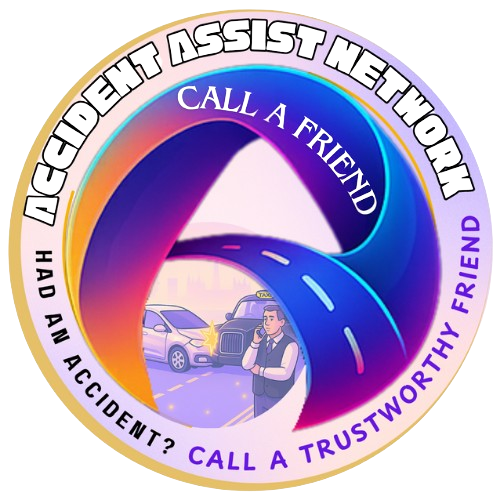Taxi & PHV non-fault claim
in the UK: the plain
English path

Your Reality
Your taxi’s off the road and every hour means lost fares. Operators still expect standards, bills won’t wait, and you need a plated, compliant like-for-like—not a tiny courtesy car. What you really want is a simple path that keeps you legal, protects earnings, and cuts the admin noise.
What this guide gives you?
Below, you’ll find a clear, UK-wide route from scene → reporting → evidence → claim route → recovery & storage → like-for-like → repairs/settlement. It’s non-promotional, practical, and linked to official sources. Use it to make faster, calmer decisions—especially when you’re juggling shifts.
Why to care ? (facts)
Road collisions are common enough to plan for: 132,977 casualties of all severities in Great Britain in 2023 and 1,624 fatalities—so knowing your steps matters. Source Taxi/PHV work is huge: 313,000 licensed vehicles in England (2024). Source
Quick facts (table)
| Topic | Key point | Official source |
|---|---|---|
| UK duties | If you couldn’t exchange details, report to the police within 24 hours | Gov.uk |
| Non-fault options | You may claim directly from the other driver’s insurer or use credit hire | Citizens Advice |
| Third-party assistance | Insurers’ Third-Party Assistance practices are set out by the ABI | ABI PDF |
| Uninsured drivers | MIB route exists for uninsured/untraced at-fault drivers | MIB |
What is a Taxi Accident
Claim?
A taxi accident claim (UK) for a non-fault crash is the process of recovering vehicle losses from the at-fault insurer: gather evidence → choose a route (own insurer, direct third-party, credit-hire, or MIB for uninsured) → recover the vehicle & arrange secure storage → obtain a plated like-for-like → proceed with repairs or total-loss settlement.
What must I do in the first
24 hours after a taxi
crash in the UK?
Stay safe, exchange details (name, address, registration; owner’s details if different), and collect evidence. If you couldn’t exchange details, report to the police within 24 hours. Capture photos, dashcam, witnesses, and location. These basics reduce disputes and speed decisions later. Sources: GOV.UK duties and Police guidance
Build a strong evidence pack (5–8 minutes)
Scene, damage, and positions (close-ups + wide shots)
Road signs/markings, weather, lighting, any CCTV locations
Dashcam clip; a short voice note with time/place/what happened
Taxi/PHV add-ons: photo of plate/licence, operator notification, booking/log for the shift
Save into a dated phone folder (YYYY-MM-DD) for quick sharing
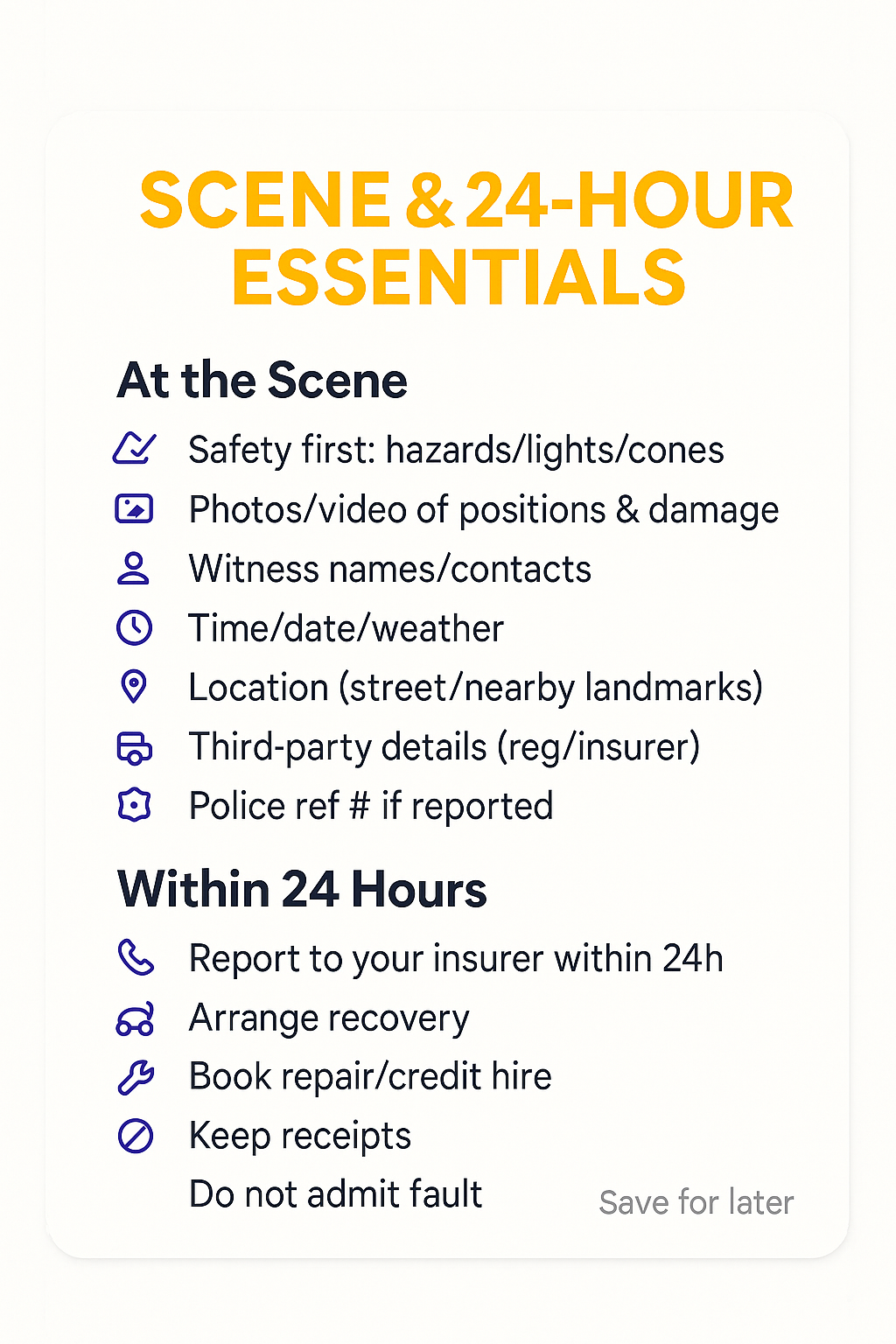
How do I choose the best route for a non-fault
taxi accident claim?
You have four common paths: (1) your own insurer, (2) claim directly from the at-fault insurer (third-party), **(3) credit hire via a coordinator to secure a like-for-like taxi, and **(4) the MIB route if the driver’s uninsured/untraced. Choose based on liability clarity, speed needs, admin tolerance, and premium considerations. (URLs below.)
Decision matrix
(choose what fits today)
| Route | Speed to replacement | Admin effort | Premium risk at renewal | Best for | Key source(s) |
|---|---|---|---|---|---|
| Own insurer | Medium | Medium | Possible (varies by insurer/model) | Simplicity; single contract | Citizens Advice: “Making a claim” link |
| Direct to third-party | Medium–High if liability is clear | Medium | Often lower than claiming on your policy (varies) | Clear rear-end or strong evidence cases | ABI Third-Party Assistance Code | Claimant Guide |
| Credit-hire via coordinator | High (aims/subject to checks) | Low | Depends on liability resolution | You need plated like-for-like fast | Citizens Advice on credit hire link |
| MIB (uninsured/untraced) | Low–Medium | High | N/A if you don’t claim on your policy | Uninsured/untraced at-fault | MIB: link |
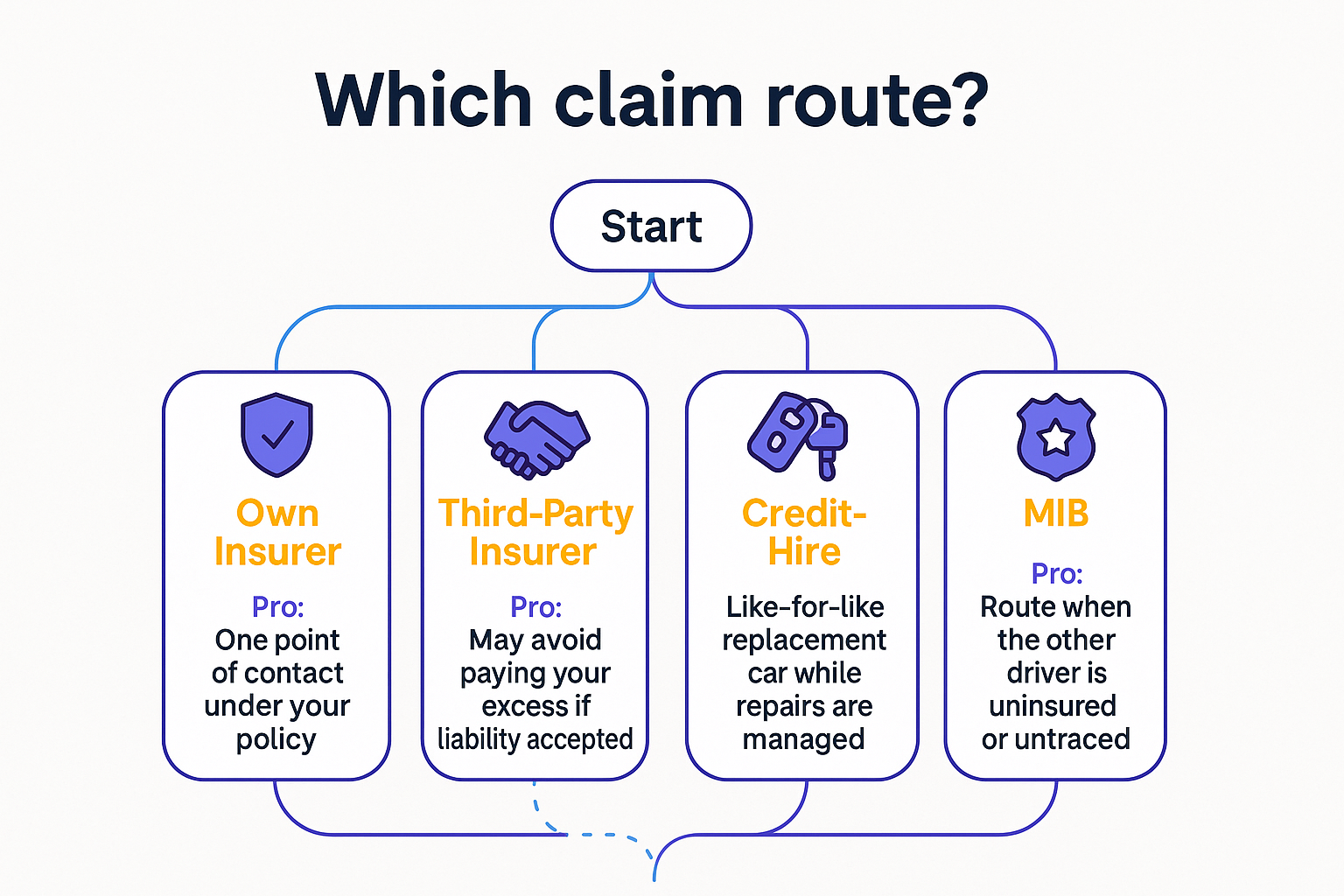
Real-world examples
(analogy table)
| Scenario | Example | Where used | Outcome |
|---|---|---|---|
| Rear-end at lights | Liability usually clear; submit photos + dashcam; claim with TP | Route choice | Faster acceptance; quicker replacement |
| Taxi off-road mid-shift | Black cab recovered; plated like-for-like arranged (aims/subject to checks) | Recovery/hire | Minimises downtime; keeps earning |
| Uninsured at-fault | Evidence gathered; MIB portal started promptly | Special cases | Route exists even if TP uninsured |
| Mixed accounts | Strong evidence pack + engineer report | Repairs/settlement | Reduces disputes and time to decision |
Prefer a broader read first? Browse more non-fault guides → Accident Assist Network
Recovery, secure storage &
like-for-like taxi/PHV
replacement
Swift recovery prevents secondary loss (weather, vandalism, penalties) and secure storage can protect you during liability disputes. If you drive for hire, request a plated, compliant like-for-like (e.g., WAV, EV/ZEC for ULEZ). Delivery is framed as an aim, subject to checks. For licensing context, see TfL taxi & PHV info
Why timing matters
Avoid street penalties and further damage while you organise the claim
Keep a record of when/where the vehicle was stored, and any notices
If disputes arise, good admin helps reduce storage-cost exposure later
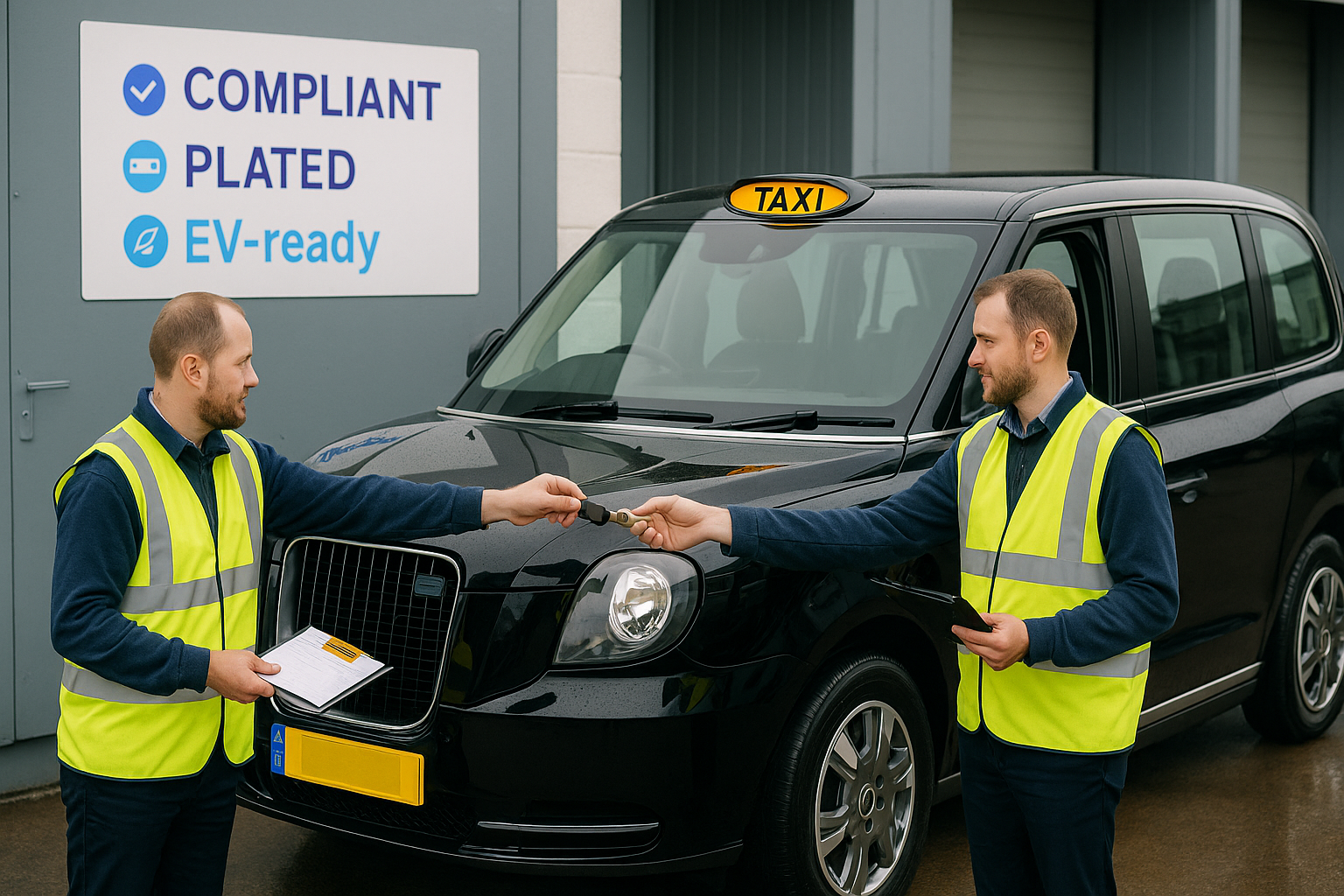
Like-for-like that fits work
Plated & compliant: black cab vs PHV; verify licence/plate match your use
Specialist needs: WAV accessibility; courier top-box for bikes; EV/ZEC range for ULEZ
Expectation setting: delivery/availability are aims, subject to checks, not guarantees
Repairs, total loss &
settlement (manufacturer
standard)
An independent engineer assesses your vehicle. If repairable, insist on manufacturer-standard methods and proper parts/warranties. If uneconomic, you’ll discuss total loss and cash-in-lieu. Keep comms clear with the repairer, and use evidence to reduce disputes. ABI claimant guidance
Repair path (OEM methods)
Request the repair plan and parts list in writing
Confirm paint, calibration, ADAS, and warranty details
Keep all invoices/engineer notes—useful if liability is challenged
Total loss & CIL, plain English
When the engineer says repair isn’t economical, insurers may make a total-loss offer. Sometimes cash-in-lieu is discussed for borderline cases. Review documents calmly, ask questions, and avoid rushing decisions.
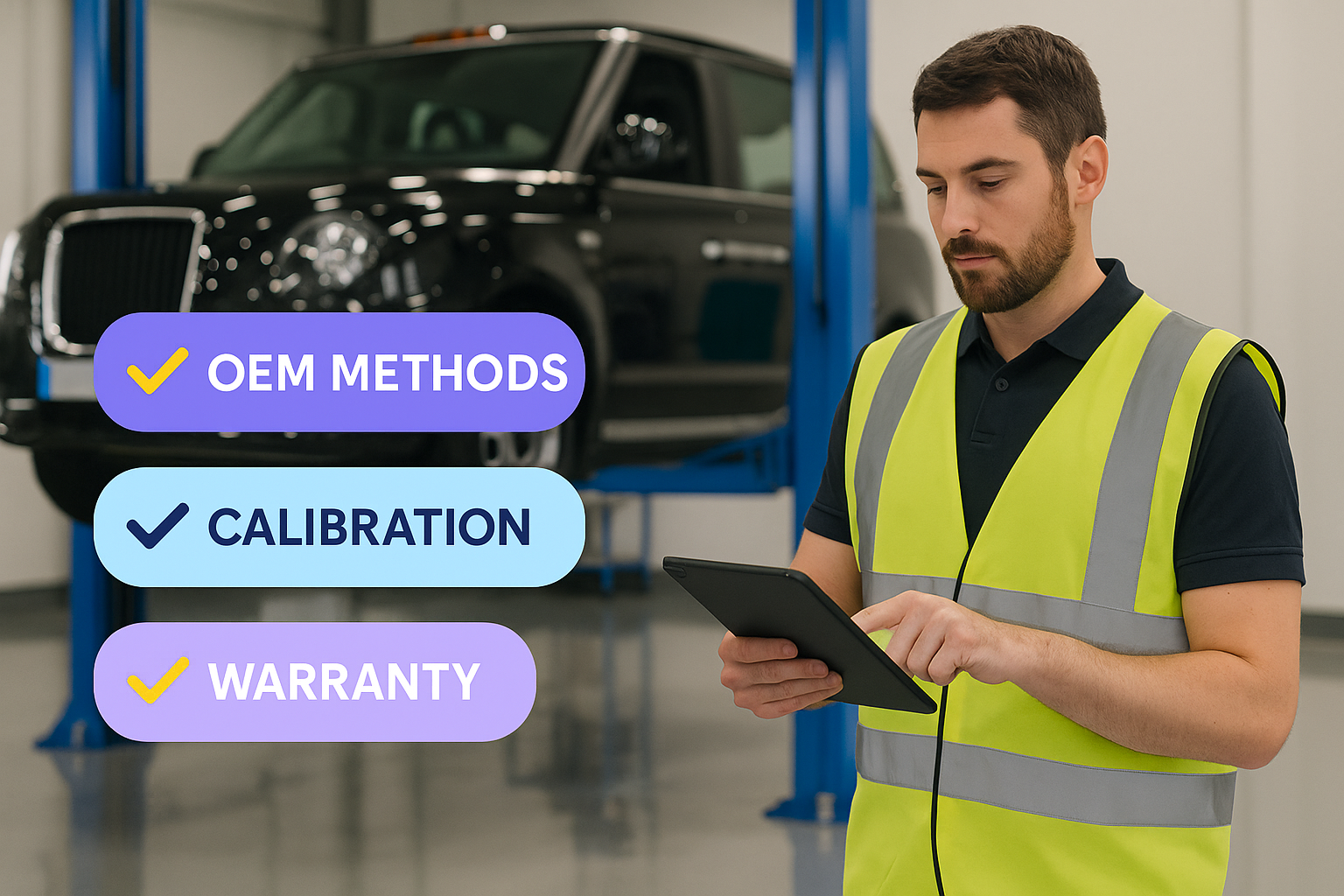
People Also Ask
Do I have to report the accident within 24 hours if I couldn’t exchange details?
Can I claim directly from the other driver’s insurer in a non-fault case?
What is credit hire for taxis and when is it suitable?
What if the other driver is uninsured or untraced—can I still recover costs?
Will a non-fault claim affect my premium in the UK?
Important Information
Accident Assist Network assists you after a non-fault accident by co-ordinating vehicle recovery, reputable repairs, cash-in-lieu settlements for total-loss vehicles and like-for-like replacement hire—whether for personal use, licensed taxi work or bike—through our network of independent specialist companies across England.
Because our role is one of practical facilitation rather than financial advice, we are not authorised by the Financial Conduct Authority, and our services are not covered by the Financial Ombudsman Service or the Financial Services Compensation Scheme.
If the at-fault insurer delays or disputes payment you may become liable for credit services or other charges set out in your contract. Please read every document thoroughly and, if anything is unclear, ask us—or an independent adviser—before signing. We are happy to guide you in the language you feel most comfortable with.
Call: 020 4577 1120 ·
WhatsApp: 07585 300 600
Conclusion: get back to
earning with less admin
empathy & path
You didn’t choose the crash, but you can choose the calm path: clear evidence, a sensible claim route, timely recovery, plated like-for-like, and manufacturer-standard repairs. This guide stays in your corner—plain-English steps, balanced choices, and official sources when it counts.
Prefer one calm point of contact to coordinate recovery, storage, like-for-like and repairs while you keep earning? Explore plated like-for-like options → , or recovery & secure storage → or simply speak to a coordinator → . Browse related articles
Mandatory Disclaimer
Accident Assist Network assists you after a non-fault accident by co-ordinating vehicle recovery, reputable repairs, cash-in-lieu settlements for total-loss vehicles and like-for-like replacement hire—whether for personal use, licensed taxi work or bike—through our network of independent specialist companies across England. Because our role is one of practical facilitation rather than financial advice, we are not authorised by the Financial Conduct Authority, and our services are not covered by the Financial Ombudsman Service or the Financial Services Compensation Scheme. If the at-fault insurer delays or disputes payment you may become liable for credit services or other charges set out in your contract. Please read every document thoroughly and, if anything is unclear, ask us—or an independent adviser—before signing. We are happy to guide you in the language you feel most comfortable with.

